Tyndall Stone EarthCache
-
Difficulty:
-

-
Terrain:
-

Size:  (not chosen)
(not chosen)
Please note Use of geocaching.com services is subject to the terms and conditions
in our disclaimer.
Note:This cache may be logged at the posted coordinates (T.C. Douglas Building) or at the Saskatchewan Legislative Assembly (Parliament Building). The back of the T.C. Douglas Building shows fossils in particular abundance, and many can be observed from the sidewalk surrounding the building making it wheelchair and winter friendly.
Everything you need can be found on the outside of the building, there is no need to enter the building (unless you want to, it is open to the public).
Tyndall Stone was first used as building stone in 1832 for the Lower Fort Garry in Manitoba and began to be commercially quarried from Garson, MB in 1895 and is still mined today.
The distinctive mottled appearance of Tyndall limestone makes it a very common building stone all over North America. Buildings that contain Tyndall stone in their construction include: Canadian Parliament Buildings in Ottawa, The Canadian Museum of Civilization in Hull, The Manitoba Legislative Building, Rimrock Hotel in Banff and the Empress Hotel in Victoria.
Tyndall stone gets its name from the town of Tyndall, 30 km northeast of Winnipeg. In geological terms it is a dolomitic limestone and comes from the Selkirk Member (Ordovician) of the Red River Formation. The sediments of the Tyndall stone were laid down in a shallow tropical sea approximately 445 million years ago.
Trace Fossils of Tyndall Stone
The ‘mottled’ texture that makes Tyndall Stone a popular decorative stone is from burrows, trails and tracks left behind in soft sediments before they ‘lithified’ or became rock. These are called Thalassinoides by ichnologists (those who study trace fossils), or more commonly trace fossils. The difference in colour between the burrows (darker) and the surrounding rock (lighter) is due to slight variations in the sediments from the inside to the outside. As the animals burrowed loosened and reworked the sediments on the inside, compared to the more tightly packed surrounding mud that hardened before the less dense sediments in the burrows. Later, fluids flowing through the rock, rich in magnesium were able to penetrate the burrows easier than the surrounding limestone allowing dolomite to be deposited in the burrows.
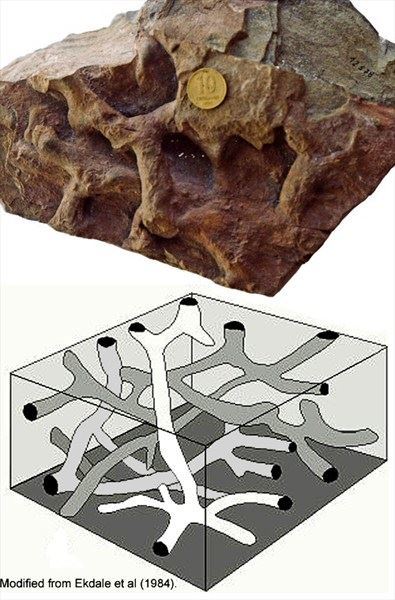
Body Fossils of the Tyndall Limestone
Body fossils are the hard, shelly remains of organisms preserved within a rock. Tyndall Limestone is notable for its rich variety of large, excellently preserved, easily-identifiable body fossils. A close look at Tyndall Limestone will reveal many interesting fossils embedded within it. The following is a list of some of the most abundant fossils of the Tyndall Limestone that you may find.
Chain Coral (Catenipora) are colonial tabulate coral (now extinct) that have an irregular grid pattern that sometimes resembles a chain, hence the common name Chain Coral. 
Horn Coral (Grewingka) is a solitary rugose coral. Individuals grew separately in the shape of a slightly curved horn (similar to a cow’s horn), hence the common name Horn Coral. If the fossil is cut across or at an oblique angle, the result is a circular or elliptical shape with lines (septa) radiating from the center. If the fossil is cut along the vertical section, it may be horn-shaped or elongated triangle shaped and the lines (septa) run along the length. 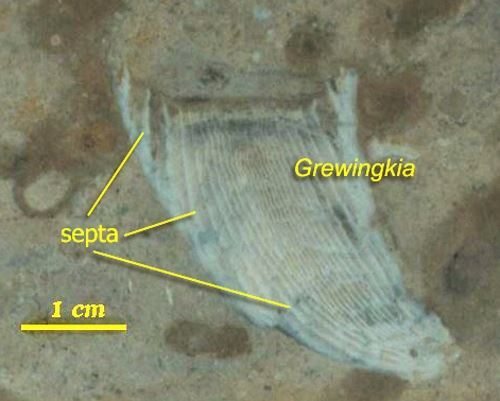
Chaetetes was a colonial tabulate coral in which the vertical tubes of the closely packed corallites are polygonal in cross-section but are extremely small. 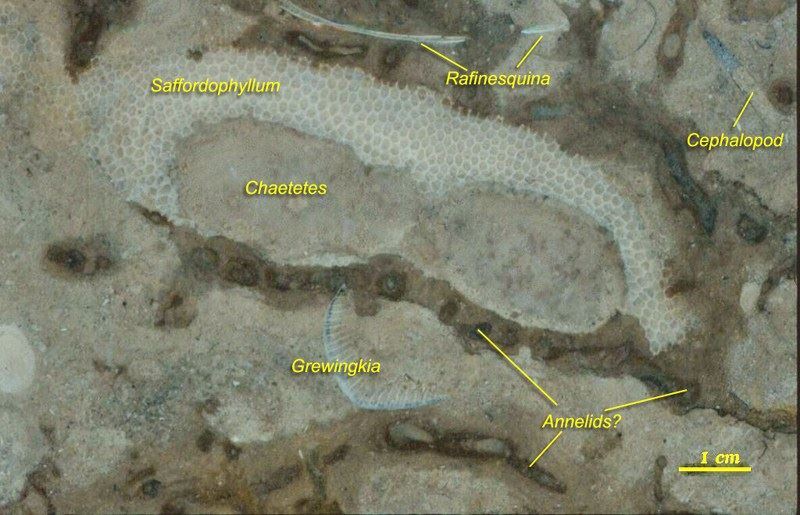
Honeycomb Coral (Saffordophyllum) was a colonial tabulate coral in which the corallite tubes are polygonal in cross-section and joined on all sides, giving them a honeycomb appearance, hence the common name Honeycomb Coral. See image above.
Sunflower ‘Coral’ (Receptaculites) are actually calcareous algae, not corals. The Fisherites variety (now extinct) grew in a large, circular colony characterized by a uniform grid-like pattern with a hollow located at the very center, resembling the center of a sunflower, hence the common (although misleading) name Sunflower Coral. 
Sea Lilies (Crinoids) are marine animals with a long stalk and a flower like stem with arms that look like flower petals, giving it the common name Sea Lilies. In the fossil record, abundant disarticulated pieces of the stem can be found that look similar to a doughnut, complete with a hole in the middle. The small size may make them difficult to identify.
Stromatoporoid were colonial animals (now extinct) in which the very small individuals formed layers as the colony grew. The Cystostroma shows grey growth layers and an encrusting habit. 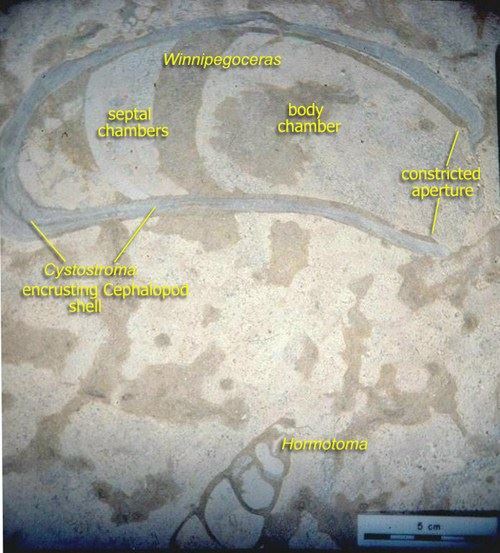
Cephalopods are a varied grouping the Tyndall stone. They are like modern squids or nautili. Common ones you may see are Orthocone (straight shells) and Winnipegoceras (curved shells). See image above.
Gastropods (Maclurites, Hormotoma) are more commonly known as snails and slugs. On a cut surface, the fossil may show the internal spiral. 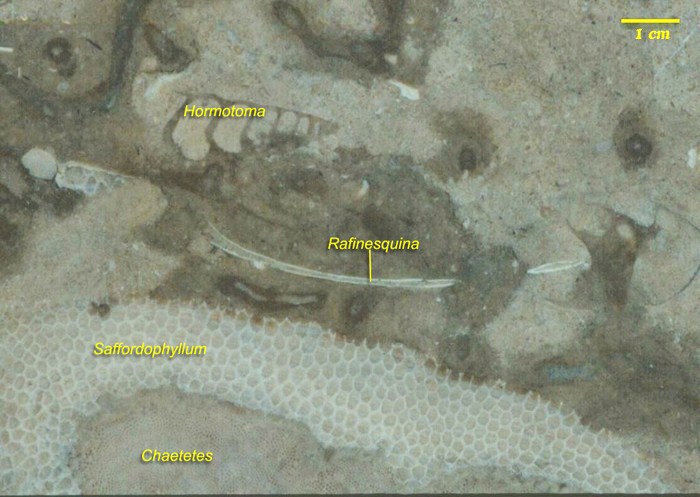
Brachiopods are similar to modern clams in that they have two shells that join at a hinge. They may be difficult to identify as you often just see one slice through a shell, but look for something long and thin, with a slight curve to it.
Trilobites may also be present but are more difficult to identify. When examining the rock for fossils, keep in mind that the shape of the fossil displayed may vary considerably depending of the random cross-section on the exposed surface of the building stone.
To log this cache:
In order to log this cache, you must do the following:
1. Email the cache owner with the average thickness of the burrows, and the percentage of the rock that is composed of burrows.
2. Post a photo or describe in an email to the cache owner at least one body fossil. Try your best to identify the fossil and make sure you include the dimensions. If you are taking a photo, you can have something in the image for scale (like your GPSr, a pencil, coin, etc.). If you are describing it, you can use a relative description of size (i.e. the length of your arm, or the size of your phone). If posting a picture, please post your answer as the picture caption.
3. State the building you took the data and images from and post the coordinates where you made the observations.
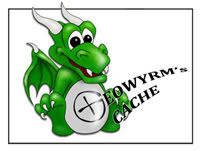
Additional Buildings Adorned with Tyndall Stone in Regina and Area:
Prince Edward Building (Historic Post Office, Old City Hall Mall, Clock Tower, Globe Theatre; Scarth St. and 11th Ave.): Built in 1906/07 (renovated 1929), the exterior is adorned with Tyndall Stone.
Scott Collegiate: pilasters capped by Tyndall Stone; Tyndall stone belt course which extends across the entire front of the building and connects the upper window lintels; The “Scott Collegiate Institute” carved Tyndall stone panel, the intricate crest centered on a Tyndall stone background and the dedicated cornerstone.
Walter Scott Building(3085 Albert Street, Regina or 12 High Street East, Moose Jaw): is clad on the outside with Tyndall Stone and the interior main floor.
Central Library: The large sculpted medallion on the north-east corner of the building is from the old library. Made of Tyndall Stone, it bears the Latin motto Qvi Legit Regit (he who reads, rules).
Credit Foncier Building & Aldon Block (1870 Cornwall St. at 12th Ave.): Built in 1911, the former Credit Union Building is of Tyndall Stone with a good selection of fossils.
The Dominion Government Building (1975 Scarth St.): now The Federal Government Building. The ground floor level is clad with Tyndall Stone, from the basement to third floor level, and with brick on the upper stories. Tyndall Stone also forms the trim, window surrounds, lintels and sills.
The Hotel Saskatchewan:(2125 Victoria Avenue) Exterior façade.
Royal Saskatchewan Museum (2445 Albert Street):
References:
Canadian Society of Petroleum Geologists, 1997. Lexicon of Canadian Stratigraphy, vol. 4: Western Canada. ed. D.J. Glass.
Coniglio, Mario. Manitoba’s Tyndall Stone. http://www.whaton.uwaterloo.ca/waton/s9911.html
Ekdale, A.A., Bromley, R.G. and Pemberton, S.G., 1984. Ichnology - trace fossils in sedimentology and stratigraphy. SEPM Short Course No. 15, 317p.
Geological Survey of Canada, 2006. Past Lives: Chronicles of Canadian Paleontology - Tyndall Limestone. http://gsc.nrcan.gc.ca/paleochron/17_e.php
Herrington, R., 2009. Scott Collegiate Institute, Regina: Architectural Heritage Significance of the (1923) Façade [http://www.realrenewal.org/dbdocs//4a1eba4301f48.pdf]
McCracken, A.D., Macey, E., Monro Gray, J.M., and Nowlan, G.S., 2007. Tyndall Limstone in GAC’s Popular Geoscience. http://www.gac.ca/PopularGeoscience/factsheets/TyndallStone_e.pdf
Paterson, D., 2006. Fossils of the Tyndall Stone (Ordovician Age), a common ornamental building stone in Canada. [http://dfp.mediacooks.com/fossils]
Additional Hints
(No hints available.)
Treasures
You'll collect a digital Treasure from one of these collections when you find and log this geocache:

Loading Treasures